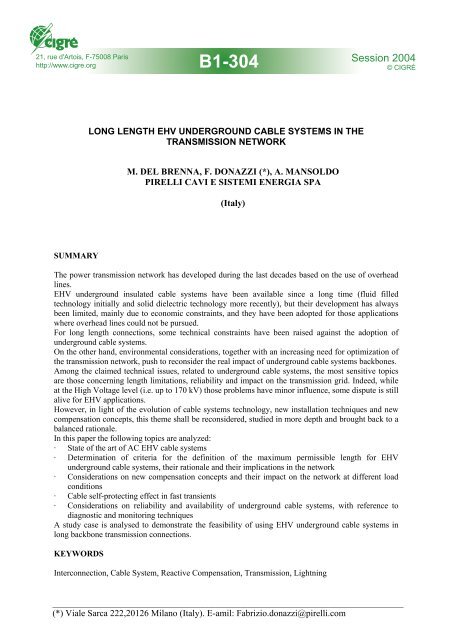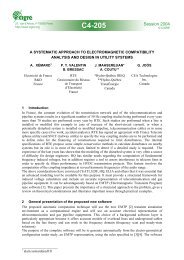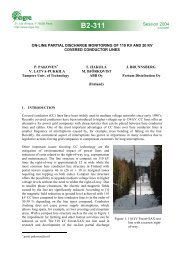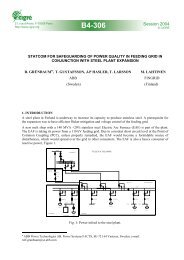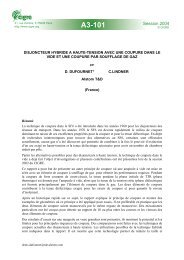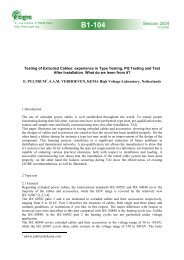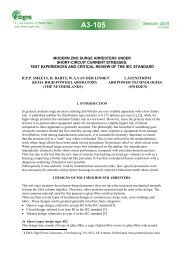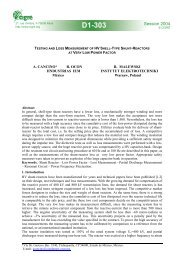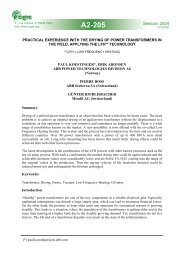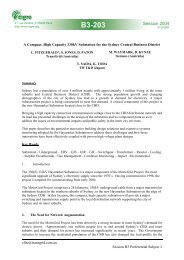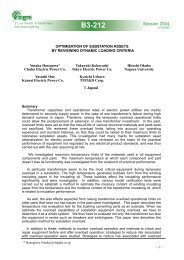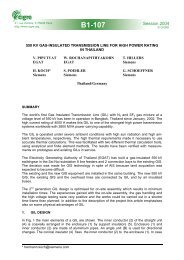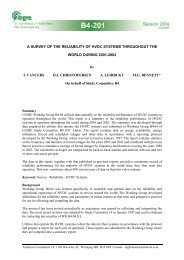Long length EHV underground cable systems in the transmission ...
Long length EHV underground cable systems in the transmission ...
Long length EHV underground cable systems in the transmission ...
Create successful ePaper yourself
Turn your PDF publications into a flip-book with our unique Google optimized e-Paper software.
21, rue d'Artois, F-75008 Paris<br />
http://www.cigre.org<br />
B1-304<br />
Session 2004<br />
© CIGRÉ<br />
LONG LENGTH <strong>EHV</strong> UNDERGROUND CABLE SYSTEMS IN THE<br />
TRANSMISSION NETWORK<br />
M. DEL BRENNA, F. DONAZZI (*), A. MANSOLDO<br />
PIRELLI CAVI E SISTEMI ENERGIA SPA<br />
(Italy)<br />
SUMMARY<br />
The power <strong>transmission</strong> network has developed dur<strong>in</strong>g <strong>the</strong> last decades based on <strong>the</strong> use of overhead<br />
l<strong>in</strong>es.<br />
<strong>EHV</strong> <strong>underground</strong> <strong>in</strong>sulated <strong>cable</strong> <strong>systems</strong> have been available s<strong>in</strong>ce a long time (fluid filled<br />
technology <strong>in</strong>itially and solid dielectric technology more recently), but <strong>the</strong>ir development has always<br />
been limited, ma<strong>in</strong>ly due to economic constra<strong>in</strong>ts, and <strong>the</strong>y have been adopted for those applications<br />
where overhead l<strong>in</strong>es could not be pursued.<br />
For long <strong>length</strong> connections, some technical constra<strong>in</strong>ts have been raised aga<strong>in</strong>st <strong>the</strong> adoption of<br />
<strong>underground</strong> <strong>cable</strong> <strong>systems</strong>.<br />
On <strong>the</strong> o<strong>the</strong>r hand, environmental considerations, toge<strong>the</strong>r with an <strong>in</strong>creas<strong>in</strong>g need for optimization of<br />
<strong>the</strong> <strong>transmission</strong> network, push to reconsider <strong>the</strong> real impact of <strong>underground</strong> <strong>cable</strong> <strong>systems</strong> backbones.<br />
Among <strong>the</strong> claimed technical issues, related to <strong>underground</strong> <strong>cable</strong> <strong>systems</strong>, <strong>the</strong> most sensitive topics<br />
are those concern<strong>in</strong>g <strong>length</strong> limitations, reliability and impact on <strong>the</strong> <strong>transmission</strong> grid. Indeed, while<br />
at <strong>the</strong> High Voltage level (i.e. up to 170 kV) those problems have m<strong>in</strong>or <strong>in</strong>fluence, some dispute is still<br />
alive for <strong>EHV</strong> applications.<br />
However, <strong>in</strong> light of <strong>the</strong> evolution of <strong>cable</strong> <strong>systems</strong> technology, new <strong>in</strong>stallation techniques and new<br />
compensation concepts, this <strong>the</strong>me shall be reconsidered, studied <strong>in</strong> more depth and brought back to a<br />
balanced rationale.<br />
In this paper <strong>the</strong> follow<strong>in</strong>g topics are analyzed:<br />
· State of <strong>the</strong> art of AC <strong>EHV</strong> <strong>cable</strong> <strong>systems</strong><br />
· Determ<strong>in</strong>ation of criteria for <strong>the</strong> def<strong>in</strong>ition of <strong>the</strong> maximum permissible <strong>length</strong> for <strong>EHV</strong><br />
<strong>underground</strong> <strong>cable</strong> <strong>systems</strong>, <strong>the</strong>ir rationale and <strong>the</strong>ir implications <strong>in</strong> <strong>the</strong> network<br />
· Considerations on new compensation concepts and <strong>the</strong>ir impact on <strong>the</strong> network at different load<br />
conditions<br />
· Cable self-protect<strong>in</strong>g effect <strong>in</strong> fast transients<br />
· Considerations on reliability and availability of <strong>underground</strong> <strong>cable</strong> <strong>systems</strong>, with reference to<br />
diagnostic and monitor<strong>in</strong>g techniques<br />
A study case is analysed to demonstrate <strong>the</strong> feasibility of us<strong>in</strong>g <strong>EHV</strong> <strong>underground</strong> <strong>cable</strong> <strong>systems</strong> <strong>in</strong><br />
long backbone <strong>transmission</strong> connections.<br />
KEYWORDS<br />
Interconnection, Cable System, Reactive Compensation, Transmission, Lightn<strong>in</strong>g<br />
_____________________________________________________________________________<br />
(*) Viale Sarca 222,20126 Milano (Italy). E-amil: Fabrizio.donazzi@pirelli.com
1. INTRODUCTION<br />
For decades electricity <strong>transmission</strong> networks have been ma<strong>in</strong>ly national and almost exclusively based<br />
on <strong>the</strong> use of overhead l<strong>in</strong>es. In recent years, however, new drivers have started to play an important<br />
role <strong>in</strong> <strong>the</strong>ir design.<br />
Electricity markets are becom<strong>in</strong>g <strong>in</strong>creas<strong>in</strong>gly liberalized and <strong>in</strong>ternationalised, and <strong>the</strong>re is a strong<br />
need, <strong>in</strong> particular <strong>in</strong> Europe, to optimise <strong>the</strong> utilization of power generation capacity and to <strong>in</strong>crease<br />
<strong>in</strong>ternational competition by <strong>in</strong>creas<strong>in</strong>g <strong>the</strong> <strong>in</strong>terconnections. Additional requirements, such as<br />
environmental compatibility, impact on population and right-of-way utilization, are also hav<strong>in</strong>g a<br />
strong impact on <strong>the</strong> def<strong>in</strong>ition of new connections, sometimes caus<strong>in</strong>g significant delays <strong>in</strong> <strong>the</strong><br />
authorization process. These delays are not acceptable to most of <strong>the</strong> new private <strong>in</strong>vestors, who have<br />
started to appear <strong>in</strong> <strong>the</strong> global scene and for whom speed is a key factor <strong>in</strong> mak<strong>in</strong>g <strong>the</strong>ir <strong>in</strong>vestments<br />
viable.<br />
On <strong>the</strong> technical side, <strong>cable</strong> system technology has reached a development level and track record that<br />
allows it to be considered as highly reliable. Fur<strong>the</strong>rmore, <strong>cable</strong> system technology can overcome <strong>the</strong><br />
limitation of traditional overhead l<strong>in</strong>es <strong>in</strong> specific situations (i.e. densely populated areas, national<br />
parks, tourist estates, etc.). Last, but def<strong>in</strong>itely not least, <strong>cable</strong> <strong>systems</strong> can easily be <strong>in</strong>serted <strong>in</strong><br />
overhead l<strong>in</strong>e based networks with no negative impact on <strong>the</strong> surround<strong>in</strong>g system, affordable<br />
technology be<strong>in</strong>g available to implement any reactive compensation or impedance balanc<strong>in</strong>g needed.<br />
2. STATE-OF-THE ART OF AC <strong>EHV</strong> CABLE SYSTEMS<br />
2.1 <strong>EHV</strong> AC <strong>cable</strong> <strong>systems</strong> with lapped <strong>in</strong>sulation<br />
Extra high voltage (<strong>EHV</strong>) <strong>cable</strong> <strong>systems</strong> of <strong>the</strong> self conta<strong>in</strong>ed oil filled type (SCOF) have been <strong>in</strong> use<br />
for many decades with excellent service records as part of bulk power <strong>transmission</strong> grids. In <strong>the</strong> mid<br />
1960’s <strong>the</strong> first 400 kV <strong>cable</strong> <strong>systems</strong> for long distances were <strong>in</strong>stalled <strong>in</strong> Europe as feeders for<br />
densely populated areas or as <strong>in</strong>terconnections between huge power generation plants and remote<br />
substations or load centres.<br />
An improvement of this technology was <strong>in</strong>troduced <strong>in</strong> <strong>the</strong> early 1980’s by replac<strong>in</strong>g <strong>the</strong> conventional<br />
Kraft paper by polypropylene lam<strong>in</strong>ated paper (PPL), which provides <strong>the</strong> advantage of low-loss<br />
<strong>in</strong>sulation.<br />
Full <strong>cable</strong> system reliability over more than 40 years is proven by <strong>the</strong> extensive field experience<br />
acquired: over 250 km of ma<strong>in</strong>ly double circuit 400 kV <strong>cable</strong> <strong>systems</strong> are now <strong>in</strong> operation <strong>in</strong> Europe<br />
alone. Similar <strong>in</strong>stallations have also been realized all over <strong>the</strong> world, e.g. <strong>in</strong> North America and<br />
Japan, even <strong>in</strong> <strong>the</strong> 500 kV range.<br />
For highest <strong>transmission</strong> capacity, <strong>cable</strong> <strong>systems</strong> with forced cool<strong>in</strong>g have been <strong>in</strong>stalled <strong>in</strong> <strong>the</strong> last 25<br />
years.<br />
2.2 <strong>EHV</strong> AC <strong>cable</strong> <strong>systems</strong> with extruded <strong>in</strong>sulation<br />
Environmental constra<strong>in</strong>ts regard<strong>in</strong>g potential leaks and <strong>the</strong> desire to m<strong>in</strong>imize regular ma<strong>in</strong>tenance<br />
were <strong>the</strong> ma<strong>in</strong> drivers to replace fluid filled with dry <strong>cable</strong>s. After extruded <strong>cable</strong>s had already proven<br />
<strong>the</strong>ir excellent service performance for several decades <strong>in</strong> <strong>the</strong> medium (MV) and high voltage (HV)<br />
ranges, great efforts were spent s<strong>in</strong>ce <strong>the</strong> 1980’s <strong>in</strong> <strong>the</strong> development of syn<strong>the</strong>tic <strong>cable</strong>s for <strong>EHV</strong><br />
applications, <strong>the</strong> ma<strong>in</strong> challenge be<strong>in</strong>g associated with high electrical stresses <strong>in</strong> <strong>cable</strong>s and<br />
accessories.<br />
Cross-l<strong>in</strong>ked polyethylene (XLPE) has proven to be <strong>the</strong> best syn<strong>the</strong>tic <strong>in</strong>sulation from <strong>the</strong> technical<br />
and economical po<strong>in</strong>ts of view.<br />
State of <strong>the</strong> art extruded <strong>EHV</strong> <strong>cable</strong>s are characterized by super-clean <strong>in</strong>sulation with well-bonded<br />
semiconductive conductor and <strong>in</strong>sulation shields, applied simultaneously <strong>in</strong> a triple extrusion and dry<br />
cur<strong>in</strong>g process. Highest cleanl<strong>in</strong>ess, absence of voids, homogeneity of <strong>the</strong> <strong>in</strong>sulation and perfect<br />
smoothness of <strong>the</strong> <strong>in</strong>terfaces with <strong>the</strong> semiconductive shields are paramount to guarantee long-term
performances. A metallic sheath and a rigid plastic oversheath protect <strong>the</strong> <strong>cable</strong> core from water and<br />
mechanical damage.<br />
The trend <strong>in</strong> accessories has gone towards factory tested prefabricated components. In particular premoulded<br />
jo<strong>in</strong>ts, characterized by s<strong>in</strong>gle-piece rubber sleeves (EPDM or SIR), are easy and reliable to<br />
<strong>in</strong>stall. Term<strong>in</strong>ations are typically equipped with prefabricated stress relief cones, placed <strong>in</strong>side<br />
syn<strong>the</strong>tic or porcela<strong>in</strong> <strong>in</strong>sulators.<br />
A precondition for <strong>the</strong> acceptance of <strong>the</strong> new <strong>cable</strong> technology was <strong>the</strong> proof of its long-term<br />
reliability [1]. Extensive test programs have been carried out and <strong>the</strong> excellent test results conv<strong>in</strong>ced<br />
all parties that long-term performances of such advanced <strong>cable</strong> <strong>systems</strong> could be considered<br />
appropriate.<br />
First long distance <strong>EHV</strong> XLPE <strong>cable</strong> <strong>systems</strong> have been <strong>in</strong>stalled s<strong>in</strong>ce <strong>the</strong> late 90’s, typical examples<br />
of which are:<br />
· 420kV XLPE <strong>cable</strong> <strong>systems</strong> with natural cool<strong>in</strong>g for 800 and 900 MVA/cct (<strong>in</strong>terconnection<br />
feeders for <strong>the</strong> city of Copenhagen, Denmark (22 km + 10 km), <strong>in</strong> service s<strong>in</strong>ce 1997 [2]<br />
· 400kV XLPE <strong>cable</strong> <strong>systems</strong> with ventilated air cool<strong>in</strong>g <strong>in</strong> tunnel for 1120 MVA/cct (diagonal<br />
<strong>in</strong>terconnection throughout <strong>the</strong> city of Berl<strong>in</strong> (~24 km), <strong>in</strong> service s<strong>in</strong>ce 1998 [3]<br />
· 500kV XLPE <strong>cable</strong> <strong>systems</strong> with tunnel and duct <strong>in</strong>stallation for 1200 MVA/cct (<strong>in</strong>terconnection<br />
feeders for <strong>the</strong> city of Tokio, Japan (~ 40 km), <strong>in</strong> service s<strong>in</strong>ce 2000 [4]<br />
· 400kV XLPE <strong>cable</strong> system with ventilated tunnel <strong>in</strong>stallation for 1720 MVA/cct (“siphon”<br />
<strong>in</strong>tersection of an exist<strong>in</strong>g OHL at Barajas Madrid Airport (~13 km), under construction)<br />
Despite its relatively young age, extruded <strong>EHV</strong> <strong>cable</strong> <strong>systems</strong> technology is conv<strong>in</strong>c<strong>in</strong>gly<br />
demonstrat<strong>in</strong>g its appropriateness and <strong>in</strong>creas<strong>in</strong>gly extend<strong>in</strong>g its application for all k<strong>in</strong>ds of<br />
<strong>in</strong>terconnections, leverag<strong>in</strong>g on some key features, e.g. reduced environmental impact, ease of<br />
<strong>in</strong>stallation and no need for ma<strong>in</strong>tenance.<br />
Dedicated efforts to save costs associated with production, components and <strong>in</strong>stallation are<br />
permanently contribut<strong>in</strong>g to <strong>in</strong>crease <strong>the</strong> competitiveness of this technology.<br />
3. MAXIMUM PERMISSIBLE LENGTH OF <strong>EHV</strong> CABLE SYSTEMS<br />
3.1 Critical <strong>length</strong>s and <strong>in</strong>fluence on <strong>cable</strong> system design parameters<br />
Overhead l<strong>in</strong>es are largely used <strong>in</strong> <strong>transmission</strong> networks due to <strong>the</strong>ir technological simplicity, low<br />
costs and suitability to transmit bulk power for long distances (100-300 km). Their ma<strong>in</strong> <strong>in</strong>tr<strong>in</strong>sic<br />
feature is a high ratio between <strong>in</strong>ductive and capacitive reactance, physically represented by <strong>the</strong><br />
characteristic impedance of <strong>the</strong> l<strong>in</strong>e.<br />
The characteristic impedance of Underground Insulated Cable Systems (UICS) is much lower, due to<br />
differences <strong>in</strong> both <strong>in</strong>ductance and capacitance. In Table 1 some reference values are given for <strong>EHV</strong><br />
<strong>systems</strong> able to transmit 2000 MVA at 500 kV. The <strong>in</strong>sulated <strong>cable</strong> capacitance is at least 15-20 times<br />
that of overhead l<strong>in</strong>es, while <strong>the</strong> <strong>cable</strong> <strong>in</strong>ductance ranges between 0.25-1 times.<br />
Table 1: Indicative reference electrical parameters for overhead l<strong>in</strong>es and <strong>underground</strong> <strong>cable</strong>s<br />
OHL<br />
1600mm 2<br />
XLPE<br />
trefoil<br />
formation<br />
(2<strong>cable</strong>s/phase)<br />
2500 mm 2 XLPE<br />
vertical formation<br />
0.5 m spaced <strong>in</strong><br />
tunnel<br />
(1 <strong>cable</strong>/phase)<br />
Current rat<strong>in</strong>g (A) 2310 2310 2310 2310<br />
Transmissible power (MVA) 2000 2000 2000 2000<br />
AC resistance (µΩm -1 ) 28 7.9 10.8 8.8<br />
Inductance (nHm -1 ) 862 192 646 760<br />
Capacitance (pFm -1 ) 14 362 205 229<br />
Characteristic impedance (Ω) 250 23 56.2 39.2<br />
Natural load (MW) 1000 10910 4490 6440<br />
3250 mm 2<br />
XLPE<br />
flat formation<br />
1m spaced<br />
(1 <strong>cable</strong>/phase)
The power rat<strong>in</strong>g of <strong>the</strong> UICS depends on <strong>the</strong> lay<strong>in</strong>g disposition and on <strong>the</strong> <strong>the</strong>rmal characteristics of<br />
<strong>the</strong> surround<strong>in</strong>g environment.<br />
Figure 1 shows a sensitive study of <strong>the</strong> rat<strong>in</strong>gs for different conductor cross sections and lay<strong>in</strong>g<br />
configurations. The 500 kV <strong>cable</strong>s here have been designed with a maximum AC electric stress of 15<br />
kV/mm and without exceed<strong>in</strong>g an electric stress of 7.8 kV/mm at <strong>the</strong> surface between <strong>in</strong>sulation and<br />
<strong>in</strong>sulation screen [5]. Before <strong>in</strong>vestigat<strong>in</strong>g <strong>the</strong> real impact of an UICS <strong>in</strong> a meshed <strong>transmission</strong><br />
system, it is necessary to def<strong>in</strong>e its maximum <strong>length</strong> technically feasible without compensation.<br />
Several criteria have been used [6, 7, 8, 9] and many are <strong>the</strong> limit<strong>in</strong>g factors which can be considered,<br />
ei<strong>the</strong>r external (i.e. steady state stability maximum angle, m<strong>in</strong>imum and maximum voltages) or<br />
<strong>in</strong>ternal (i.e. critical charg<strong>in</strong>g current, <strong>transmission</strong> efficiency, <strong>cable</strong> BIL). Additional constra<strong>in</strong>ts,<br />
which are not considered <strong>in</strong> this paper, may appear for specific scenarios as for <strong>in</strong>stance radial<br />
connection of generators, to <strong>the</strong> ma<strong>in</strong> grid.<br />
As regards <strong>transmission</strong> efficiency many approaches have been proposed [6,8,9].<br />
2600<br />
2400<br />
Power rat<strong>in</strong>g [MVA]<br />
2200<br />
2000<br />
1800<br />
1600<br />
1400<br />
S=1600 (mm²)<br />
S=2000 (mm²)<br />
S=2500 (mm²)<br />
S=3250 (mm²)<br />
S=4000 (mm²)<br />
1200<br />
1000<br />
0 500 1000 1500 2000 2500<br />
Phase spac<strong>in</strong>g [mm]<br />
Figure. 1: Rat<strong>in</strong>g of 500 kV XLPE <strong>underground</strong> <strong>cable</strong> <strong>systems</strong><br />
Accord<strong>in</strong>g to [6] <strong>the</strong> optimum <strong>cable</strong> circuit <strong>length</strong> is <strong>the</strong> one that realizes, at <strong>the</strong> nom<strong>in</strong>al <strong>cable</strong> power,<br />
<strong>the</strong> maximum active power transfer between generation and load. The results are very sensitive to <strong>the</strong><br />
“optimal” cos φ. For load power factors (LPF) close to <strong>the</strong> maximum (cos φ ≅1), <strong>the</strong> Abacus <strong>in</strong> Figure<br />
4 of [6] leads to maximum <strong>length</strong>s close to nil, while for typical LPF (cos φ ≅0.95) <strong>length</strong>s of <strong>the</strong> order<br />
of 100 km are obta<strong>in</strong>ed.<br />
In [8, 9] <strong>the</strong> maximum <strong>length</strong> is <strong>the</strong> one def<strong>in</strong>ed as <strong>the</strong> “<strong>Long</strong>ueur d’Aptitude au Transport (LAT)”<br />
which “guarantees that <strong>the</strong> (active NdR) power effectively transmitted be not less than 95% of <strong>the</strong><br />
total power <strong>in</strong>put”, when <strong>the</strong> load power factor is equal to 1 (pure resistive load).<br />
In order to better expla<strong>in</strong> <strong>the</strong> LAT concept, some remarks are given below.<br />
3.1.1 LAT (<strong>Long</strong>ueur d’Aptitude au Transport )<br />
For a generic load <strong>the</strong> follow<strong>in</strong>g equations can be considered:<br />
⎪⎧<br />
V<br />
⎨<br />
⎪⎩ I<br />
RE<br />
RE<br />
= A ⋅ V<br />
SE<br />
= −C<br />
⋅ V<br />
SE<br />
− B ⋅ I<br />
+ A ⋅ I<br />
SE<br />
SE<br />
(1<br />
)<br />
⎧ V =<br />
SE Vn<br />
⎪<br />
⎪ 2 2<br />
⎨<br />
PSE<br />
+ QSE<br />
= S<br />
⎪PRE<br />
= ρ ⋅ Sn<br />
⎪<br />
⎩QRE<br />
= tgϕ ⋅PRE<br />
n<br />
(2)<br />
⎧ρ=<br />
0.95<br />
⎨<br />
⎩cos(<br />
ϕ)<br />
= 1.<br />
(3)
In (1), <strong>the</strong> quadrupole equations from receiv<strong>in</strong>g to send<strong>in</strong>g ends (RE and SE) have been considered,<br />
with A , B, C represent<strong>in</strong>g <strong>the</strong> complex <strong>transmission</strong> coefficients that depend on circuit<br />
electromagnetic parameters and V and I <strong>the</strong> complex voltage and current respectively.<br />
In (2) general boundary conditions have been <strong>in</strong>troduced, <strong>in</strong> terms of nom<strong>in</strong>al circuit power (S n ) <strong>in</strong><br />
terms of real (P) and reactive (Q) components, load power factor relations (tg ϕ), and ‘efficiency’<br />
requirements from <strong>the</strong> send<strong>in</strong>g to <strong>the</strong> receiv<strong>in</strong>g ends (ρ).<br />
In (3) fur<strong>the</strong>r constra<strong>in</strong>ts are considered; <strong>the</strong>y are <strong>in</strong>cluded <strong>in</strong> <strong>the</strong> LAT def<strong>in</strong>ition itself.<br />
In Figure 2 <strong>the</strong> reference circuit is shown.<br />
~<br />
SE : send<strong>in</strong>g end<br />
S=S n = Cable nom<strong>in</strong>al power<br />
V se : V nom<strong>in</strong>al<br />
RE : receiv<strong>in</strong>g end<br />
P re =P load<br />
Power factor = 1<br />
LAT: Length |<br />
P<br />
RE = 95%<br />
S<br />
n<br />
Figure 2: Reference scheme for LAT calculation<br />
This def<strong>in</strong>ition is of particular <strong>in</strong>terest, as it takes <strong>in</strong>to account, at <strong>the</strong> same time, <strong>in</strong>tr<strong>in</strong>sic electrical<br />
parameter effects, nom<strong>in</strong>al grid work<strong>in</strong>g conditions, near optimum transfer power requirements and<br />
worst scenario load factor. The LAT curves relevant to <strong>the</strong> 500 kV UICS with cross section<br />
1x1600mm 2 and 1x2500mm 2 described <strong>in</strong> Table 1, are shown <strong>in</strong> Figure 3. It appears that <strong>the</strong> results of<br />
[8] for <strong>the</strong> trefoil formation are confirmed. However, with large phase spac<strong>in</strong>g, efficient (LAT)<br />
<strong>length</strong>s, even greater than 50 km, <strong>in</strong> a bulk power <strong>transmission</strong> system, can be reached without any<br />
60<br />
55<br />
50<br />
Trefoil<br />
formation<br />
LAT [km]<br />
45<br />
40<br />
35<br />
30<br />
25<br />
S=1600 mm²<br />
S=2500 mm²<br />
20<br />
0 500 1000 1500 2000<br />
Phase spac<strong>in</strong>g [mm]<br />
Phase spac<strong>in</strong>g [mm]<br />
Figure. 3: LAT- for <strong>the</strong> 500 kV UICS considered<br />
compensation device.<br />
It is noteworthy to outl<strong>in</strong>e that, for UICS laid <strong>in</strong> a ventilated tunnel, an <strong>in</strong>crease <strong>in</strong> LAT up to 60% can<br />
be obta<strong>in</strong>ed even for reduced phase spac<strong>in</strong>g, as shown <strong>in</strong> Figure 4 (LAT-tunnel). This is due to<br />
nom<strong>in</strong>al work<strong>in</strong>g conditions, which are closer to <strong>the</strong> Surge Impedance Load Level (SIL), where LAT,<br />
<strong>in</strong> a loss free l<strong>in</strong>k, would be <strong>in</strong>f<strong>in</strong>ite.
3.1.2 LAT and reactive compensation<br />
When generaliz<strong>in</strong>g LAT def<strong>in</strong>ition, add<strong>in</strong>g <strong>in</strong>ductance <strong>in</strong> parallel to <strong>the</strong> resistive load, i.e. when shunt<br />
compensation devices are <strong>in</strong>stalled at <strong>the</strong> RE of <strong>the</strong> UICS, a fur<strong>the</strong>r LAT <strong>in</strong>creas<strong>in</strong>g effect is obta<strong>in</strong>ed.<br />
As an example, Figure 4 shows <strong>the</strong> LAT <strong>in</strong>crease for <strong>the</strong> 2500 mm 2 UICS when 50% of shunt<br />
compensation at <strong>the</strong> receiv<strong>in</strong>g end is adopted (see curve LAT_sh50%).<br />
3.2 Summary of <strong>cable</strong> <strong>length</strong> constra<strong>in</strong>ts<br />
LAT [km]<br />
250<br />
200<br />
150<br />
100<br />
50<br />
0<br />
( 0.95)<br />
( ∆ϑ)<br />
2<br />
( Vn<br />
) − 3 ⋅ ( Z<br />
cIn<br />
)<br />
2<br />
( V ) + 3 ⋅ ( Z I )<br />
LAT_sh50%<br />
L-DV<br />
Lcrit<br />
0 500 1000 1500 2000<br />
L-Stab. - 15(°)<br />
Phase spac<strong>in</strong>g [mm]<br />
LAT - tunnel<br />
Figure. 4: 500 kV, 2500 mm 2 UICS - Length limitations vs. phase spac<strong>in</strong>g<br />
⎧<br />
⎪L<br />
⎪<br />
⎪<br />
⎨L<br />
⎪<br />
⎪<br />
⎪L<br />
⎪<br />
⎩<br />
STAB<br />
CRIT<br />
DV<br />
1 ⎛ Pc<br />
= arctan⎜<br />
β ⎝<br />
1 ⎛<br />
= arccos⎜<br />
2β<br />
⎝<br />
1<br />
arccos<br />
≅<br />
β<br />
⋅ tg<br />
n<br />
P<br />
⎞<br />
⎟<br />
⎠<br />
LAT<br />
c n<br />
2<br />
2<br />
⎞<br />
⎟<br />
⎠<br />
(4)<br />
(5)<br />
(6)<br />
For reference <strong>the</strong> 500 kV 2500 mm 2 XLPE UICS configuration shown <strong>in</strong> Table 1 has been considered.<br />
The Steady State stability limit “L STAB ” has been calculated accord<strong>in</strong>g to (4), consider<strong>in</strong>g an angle<br />
sw<strong>in</strong>g ∆ϑ = 15° between SE and RE; whereas P c is <strong>the</strong> <strong>cable</strong> SIL and β is <strong>the</strong> propagation constant.<br />
The Charg<strong>in</strong>g Current limit evaluation “L crit “ has been calculated accord<strong>in</strong>g to (5), <strong>in</strong> no-load<br />
conditions, where V n and I n are <strong>the</strong> nom<strong>in</strong>al <strong>cable</strong> voltage and current rat<strong>in</strong>g, and Z c is <strong>the</strong><br />
characteristic impedance. The Voltage Variation limit “L DV ”, has been calculated accord<strong>in</strong>g to (6), <strong>in</strong><br />
no-load conditions with a 5% voltage difference between SE and RE. As Figure 4 shows, <strong>the</strong> LAT is<br />
<strong>the</strong> most limit<strong>in</strong>g constra<strong>in</strong>t for any traditional <strong>underground</strong> configuration studied. However, <strong>in</strong> case of<br />
forced cooled circuits with large phase spac<strong>in</strong>g, <strong>the</strong> voltage variation “L DV “ constra<strong>in</strong>t can become <strong>the</strong><br />
limit<strong>in</strong>g criteria, as shown by <strong>the</strong> curve “LAT-tunnel” of Figure 4 <strong>in</strong> correspondence of 1600 mm<br />
spac<strong>in</strong>g.<br />
3.3 Cable self-protect<strong>in</strong>g <strong>length</strong><br />
Although not directly <strong>in</strong>fluenc<strong>in</strong>g <strong>the</strong> maximum feasible <strong>length</strong>, <strong>cable</strong> self-protect<strong>in</strong>g <strong>length</strong> is<br />
somehow important <strong>in</strong> <strong>in</strong>sulation coord<strong>in</strong>ation studies, <strong>in</strong> scenarios <strong>in</strong>clud<strong>in</strong>g OHL and UICS. Due to<br />
discont<strong>in</strong>uities on surge impedance, <strong>the</strong> transition po<strong>in</strong>t is often protected by surge arresters aga<strong>in</strong>st<br />
overvoltages driven <strong>in</strong>to <strong>the</strong> <strong>cable</strong> by lightn<strong>in</strong>g strokes on OHL. Wave reflections cause <strong>the</strong> ris<strong>in</strong>g of<br />
<strong>the</strong> voltage on <strong>the</strong> <strong>cable</strong> itself that sometimes can exceed <strong>the</strong> Cable BIL. The factors <strong>in</strong>fluenc<strong>in</strong>g <strong>the</strong><br />
voltage <strong>in</strong>crease, ma<strong>in</strong>ly depend on:<br />
· Lightn<strong>in</strong>g stroke current shape<br />
· Lightn<strong>in</strong>g strike po<strong>in</strong>t distance from <strong>the</strong> <strong>cable</strong>.<br />
· OHL Vs. UICS surge impedance ratio.<br />
· Scenarios at <strong>the</strong> far end of <strong>the</strong> <strong>cable</strong> like a substation (see Figure 5) or an OHL/siphon (Figure 7)<br />
· Cable BIL
In Figure 6 results are shown for <strong>the</strong> worst case scenario, i.e. a substation at <strong>the</strong> far end, with a<br />
lightn<strong>in</strong>g current of 200 kA 4/250 µs, strik<strong>in</strong>g <strong>the</strong> OHL 10 km away from <strong>the</strong> entrance of <strong>the</strong> <strong>cable</strong>.<br />
The UICS <strong>length</strong> has been varied from 1500 m to 2000 m.<br />
Zc<br />
Cable SE<br />
Cable RE<br />
10 km 1500 m ÷ 2000 m<br />
Figure.5. UICS Connect<strong>in</strong>g a substation<br />
V [p.u.]<br />
1.4<br />
1.2<br />
1.0<br />
0.8<br />
a) L=1500 m<br />
b) L=2000 m<br />
BIL p.u.<br />
0.6<br />
0.4<br />
0.2<br />
0.0<br />
0.00 0.05 0.10 0.15 0.20 0.25 0.30<br />
0.00 0.05 0.10 0.15 0.20 0.25 0.30<br />
Time [ms]<br />
Figure.6. (a,b) Voltage on <strong>the</strong> OHL (red), Voltage on UICS: SE (green), RE (blue)<br />
Zc<br />
Cable SE<br />
Cable RE<br />
10 km 100 m<br />
Figure.7. UICS <strong>in</strong> siphon configuration<br />
Zc<br />
a) L=100 m, lightn<strong>in</strong>g stroke: 4/50 µs b) L=100 m, lightn<strong>in</strong>g stroke: 4/500 µs<br />
V [p.u.]<br />
1.0<br />
0.8<br />
0.6<br />
0.4<br />
0.2<br />
0<br />
0.00 0.04 0.08 0.12<br />
0.00 Time [ms]<br />
0.04 0.08 0.12 0.16 0.20<br />
Figure 8 a) Voltage on <strong>the</strong> OHL (red), Voltage on UICS: SE (green) RE (blue)<br />
b) Voltage on <strong>the</strong> OHL (green), Voltage on UICS: SE (blue) RE (violet)
S<strong>in</strong>ce OHL and UICS have <strong>the</strong> same BIL, overvoltage exceeds <strong>the</strong> BIL for UICS <strong>length</strong>s around 1500<br />
m (Figure 6 a) whereas for longer <strong>length</strong>s, i.e. 2000 m, it does not. In fact (see Figure 6 b), both SE<br />
and RE Voltages stay with<strong>in</strong> <strong>the</strong> BIL and <strong>the</strong>refore no extra protection devices are necessary.<br />
Shorter distances of <strong>the</strong> strik<strong>in</strong>g po<strong>in</strong>t from <strong>the</strong> <strong>cable</strong> entrance could <strong>in</strong>crease <strong>the</strong> self-protect<strong>in</strong>g<br />
distances. On <strong>the</strong> contrary, <strong>in</strong> <strong>the</strong> siphon scenario, <strong>cable</strong> BIL is never exceeded whatever be <strong>the</strong> <strong>cable</strong><br />
<strong>length</strong> and <strong>the</strong> lightn<strong>in</strong>g current shape (Figure 8 a, b).<br />
4. RELIABILITY AND AVAILABILITY: DIAGNOSTIC AND MONITORING<br />
The <strong>in</strong>troduction of XLPE <strong>in</strong>sulated <strong>cable</strong>s has raised some concerns regard<strong>in</strong>g long-term life s<strong>in</strong>ce, <strong>in</strong><br />
modern high voltage <strong>cable</strong> <strong>systems</strong>, temperature, overloads and water <strong>in</strong>gress may become time<br />
limitation parameters for <strong>the</strong> system lifetime. Utilities expect highest reliability from UICS and an<br />
obvious demand is <strong>the</strong> need for little or no ma<strong>in</strong>tenance <strong>in</strong> spite of higher utilisation. Third party<br />
damage, fault location and ma<strong>in</strong>tenance have been among <strong>the</strong> most penaliz<strong>in</strong>g factor for UICS<br />
availability so far.<br />
Two <strong>systems</strong> have already been <strong>in</strong>troduced <strong>in</strong>to commercial plants and have shown <strong>the</strong>ir excellent<br />
performances. The ma<strong>in</strong> capability of <strong>the</strong> first system, called Real Time Thermal Rat<strong>in</strong>g (RTTR) is <strong>the</strong><br />
dynamical evaluation of <strong>the</strong> permissible load of a given <strong>cable</strong> circuit and its environmental variable<br />
conditions. RTTR is based on cont<strong>in</strong>uous temperature and load monitor<strong>in</strong>g [10].<br />
Concern<strong>in</strong>g to <strong>the</strong> second monitor<strong>in</strong>g system, it is noteworthy to outl<strong>in</strong>e that XLPE <strong>cable</strong>s do not need<br />
any ma<strong>in</strong>tenance, provided <strong>the</strong> <strong>cable</strong> sheath is impervious to possible water penetration <strong>in</strong>to <strong>the</strong> <strong>cable</strong><br />
<strong>in</strong>sulation. The water monitor<strong>in</strong>g system has been developed to recognise <strong>the</strong> <strong>in</strong>gress of water<br />
immediately when enter<strong>in</strong>g <strong>in</strong> an accidentally damaged <strong>cable</strong> sheath [11].<br />
5. CONCLUSIONS<br />
Technological developments allow nowadays a much broader use of <strong>cable</strong> <strong>systems</strong> for AC power<br />
<strong>transmission</strong> applications. Availability of two families of <strong>cable</strong> <strong>systems</strong>, fluid filled and extruded, <strong>the</strong><br />
comb<strong>in</strong>ation of <strong>the</strong> long stand<strong>in</strong>g experience of <strong>the</strong> first and <strong>the</strong> environmental friendl<strong>in</strong>ess of <strong>the</strong><br />
latter, allow <strong>the</strong> def<strong>in</strong>ition of optimized solutions for all k<strong>in</strong>ds of applications.<br />
In particular accurate and unprejudiced network analysis and system design, <strong>in</strong>clud<strong>in</strong>g <strong>in</strong>stallation, can<br />
significantly <strong>in</strong>crease <strong>cable</strong> <strong>systems</strong> circuit <strong>length</strong>s well above 50 km without reactive compensation.<br />
If reactive compensation is adopted, and today’s technology allows its use at limited costs, <strong>the</strong> limits<br />
<strong>in</strong> maximum <strong>cable</strong> <strong>length</strong>s virtually disappear.<br />
Overhead l<strong>in</strong>es are and will cont<strong>in</strong>ue to be an important means of power <strong>transmission</strong>, especially for<br />
very long backbone l<strong>in</strong>ks <strong>in</strong> areas where no environmental concerns may be raised.<br />
The smart comb<strong>in</strong>ation of <strong>the</strong> two technologies, based on <strong>the</strong> specific drivers of each project is <strong>the</strong> key<br />
for <strong>the</strong> realization of efficient and reliable <strong>transmission</strong> networks.<br />
6. REFERENCES<br />
[1] CIGRE WG 21-03, “Recommendations for electrical tests…”, Electra No. 151, Dec. 1993.<br />
[2] P. Andersen et al., “Development of a 420 kV XLPE <strong>cable</strong> system for <strong>the</strong> metropolitan power<br />
project <strong>in</strong> Copenhagen”, CIGRE paper 21-201, 1996<br />
[3] C.H. Henn<strong>in</strong>gsen et al., “New 400 kV long distance <strong>cable</strong> <strong>systems</strong>, <strong>the</strong>ir first application for <strong>the</strong><br />
power supply of Berl<strong>in</strong>”, CIGRE paper 21-109, 1998<br />
[4] H. Ohno et al., “Construction of <strong>the</strong> World’s first long-distance 500 kV XLPE <strong>cable</strong> l<strong>in</strong>e”, CIGRE<br />
paper 21-106, 2000<br />
[5] A. Bolza, B. Parmigiani, F. Donazzi, C. Bisleri, “Prequalification Test Experience On <strong>EHV</strong> XLPE<br />
Cable System”, CIGRÉ paper 21-104, 2002.<br />
[6] R. Arrighi, “Operat<strong>in</strong>g Characteristics of <strong>Long</strong> L<strong>in</strong>ks of AC High Voltage Insulated Cables”,<br />
CIGRÉ paper 21-13, 1986<br />
[7] P. Argaut, J. Becker, P.M. Dejean, S. S<strong>in</strong>, E. Dorison, “Studies and Development <strong>in</strong> France of<br />
400kV Cross-L<strong>in</strong>ked Polyethylene Cable Systems”, CIGRÉ paper 21-203, 1996.
[8] P. Couneson, J. Lamsoul, X. Delre, X. Van Merris, “Bulk Power Transmission By OHL or Cables.<br />
Comparative Assessment and Pr<strong>in</strong>ciples Adopted <strong>in</strong> Belgium for <strong>the</strong> Future Development of <strong>the</strong> HV<br />
Network”, CIGRÉ paper 21/22-09, 1996.<br />
[9] EDF, “Réseaux électriques et environnement”, Épure N° 48, Octobre 1995, (pag.39).<br />
[10] F. Donazzi, R. Gaspari, “Method and system for <strong>the</strong> Management of power <strong>cable</strong> l<strong>in</strong>ks”, CIGRÉ<br />
paper 21-203, 1998.<br />
[11] L. Goehlich, F. Donazzi, R. Gaspari, “Monitor<strong>in</strong>g of HV <strong>cable</strong>s offers improved reliability and<br />
economy by means of power sensors” Power Eng<strong>in</strong>eer<strong>in</strong>g Journal, June 2002.


